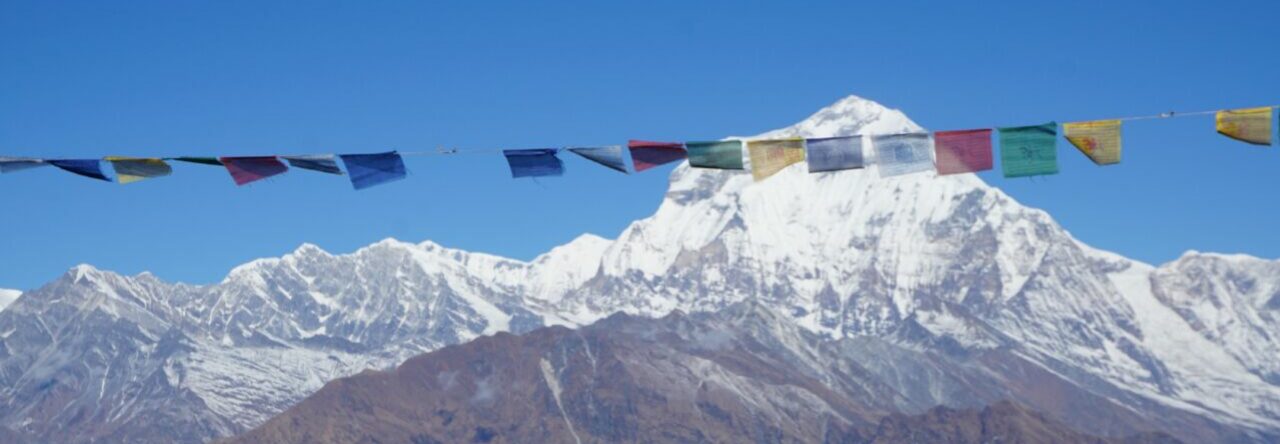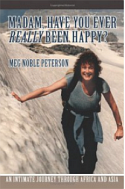December 13 – 14, 2018
At 10 AM we said goodbye to our comfortable room and hopped into the jeep for the long drive to Pokhara. To tell you the truth, I’d much rather have slept in a tent in the woods and awakened to see Machapuchare with its fishtail shining pink in the morning light, then packed up and hiked down a steep hill through a forest that suddenly opened up onto Phewa Lake, one of the eight lakes in the Pokhara Valley. But that was not to be this time around.
 We were happy for the Buddha on the dashboard watching out for us as we drove down impossible roads for 6 ½ hours, with delays, dust, and enormous potholes, wondering when we’d go over a cliff. It was also comforting to know that we had an excellent driver with a sense of humor and nerves of steel! We built up a robust camaraderie as we wound down the “soon to be a highway” with its plethora of road building equipment—the backhoe competing with the front-end loader, and the excavator making light work of them all.
We were happy for the Buddha on the dashboard watching out for us as we drove down impossible roads for 6 ½ hours, with delays, dust, and enormous potholes, wondering when we’d go over a cliff. It was also comforting to know that we had an excellent driver with a sense of humor and nerves of steel! We built up a robust camaraderie as we wound down the “soon to be a highway” with its plethora of road building equipment—the backhoe competing with the front-end loader, and the excavator making light work of them all.
What always amazed me, however, was the number of school children nattily dressed in their uniforms, laughing and chatting as they calmly made their way up the hill next to the machines, with nary a glance. As a parent, I was terrified. The road was hardly big enough for two large vehicles to pass one other, and there they were, walking on the side, oblivious to the danger.
The road being constructed was cut out of the cliffs and banks of the Seti Gandaki Khola (river).
(Click on photos to enlarge.)
We passed groups of men huddled over piles of rocks; some digging ditches, some hammering large stones into small pieces, and some building the wire containers for flat rocks that are used to fortify the bottom of a hill or act as guard rails. They also operated the large equipment with great gusto. It was a young boy’s dream!
Several times we were stopped while cars passed or digging took precedence. During these stops we had time to examine various rocks and check out the landscape, seeing, first-hand, how difficult it was to cut through the hills abutting the river.
We also marveled at the high voltage transmission lines with their enormous towers. These infrastructure projects will change many lives through improved transportation and access to electricity.
Buddhi gave us some background on the young men who worked such long hours on the road. Usually, they were hired to work for a year non-stop and made about 1,000 rupees, approximately $10, a day. During that time, they lived in various makeshift, rather primitive accommodations, which were quite depressing to me. But this road will get done, Buddhi assured us. Nepalis are tenacious. And that was that….

We stopped for a short coffee break,
and then continued on until reaching the crowded, bustling town of Beni, where we had lunch.
 The Yak Restaurant was charming—round outdoor gazebos with thatched roofs and curtains for privacy. And the food was really good, albeit a bit spicy. It was the first time Buddhi had allowed us to have yogurt, since he didn’t think it was safe in the mountains. My special treat for the day!
The Yak Restaurant was charming—round outdoor gazebos with thatched roofs and curtains for privacy. And the food was really good, albeit a bit spicy. It was the first time Buddhi had allowed us to have yogurt, since he didn’t think it was safe in the mountains. My special treat for the day!
For another few hours we wound around the hills and river and navigated the construction. Then we left the river valley, and the roads transitioned to paved.
By 4 PM we could see the hills and small communities around Pokhara and upon arrival there, were welcomed to The Big Pillow, a new hotel near the downtown shopping district.
It was all very posh, much more so than the last time I was in Pokhara in 1999. There were balconies with designer railings, spotless marble hallways and stairs, the slowest elevator so far (we chose to walk the six floors), and a shower that would rival the Tatopani hot springs! We loved it! (Covid-19 update – the Big Pillow closed for the pandemic, but is hoping to reopen soon when it’s over!)
At dusk approached, walking along the shoreline of beautiful Phewa Lake with its myriad boats, we found ourselves inside the confines of an extensive fish hatchery. Talking to one of the owners, we discovered that there are twenty-five types of fish being grown. Some operation! We also enjoyed talking to a group of school children, who wanted to try out their English as well as sell us tickets to their new production of Charlie and the Chocolate Factory. We declined, but gave a contribution to the school for which they were very grateful.
Before we retired to our luxurious bedroom, our host took us to the roof garden and proudly showed us the extensive eco-setup he had installed for getting hot water from large highly-insulated tanks placed on the roof. For the next hour we sat on the roof, watched the lights come on all over town, and drank a celebratory beer as the sun set over the Annapurna Range.
In the morning, as I lay sleeping, Cary got up early to take photos of the sunrise.
We returned to say goodbye to the lake and have coffee in a small café by the shore. We mingled with the tourists as we perused the downtown shops, enjoying the cleanliness of the modern stores. Not able to resist a fancy Kashmiri shop, we stepped in to buy some elaborate shawls and immediately felt very much at home, sensing that bargaining was expected. We were able to get a “very good price” as “first customers” of the day. Where had we heard that before? Nevertheless, this town was so different from any other place I’d been in Nepal. No crazy motorcyclists, no crowded sidewalks, no open ditches and streets being repaired, no tangle of traffic. It’s Nepal’s second largest city and its largest tourist center.
The little Pokhara airport (they’re building a bigger one) had a great rooftop restaurant where we enjoyed very tasty veg chow mein, and then waited for Yeti Airlines to take us on our 90 minute flight to Kathmandu.
So many mixed feelings as we took off. So many thoughts. So much had changed in the mountains since my last trip. But isn’t change all you can really depend on? What will be will be. Cary and I both felt emotional as we photographed scenes during the flight. The end of an amazing journey. How happy and lucky we were!

























































































 As we negotiated the rocky trail down, we were grateful for the occasional chautari (a rest stop made by piling stones to create a platform for sitting) to refresh ourselves.
As we negotiated the rocky trail down, we were grateful for the occasional chautari (a rest stop made by piling stones to create a platform for sitting) to refresh ourselves.




























































































































































































































































































